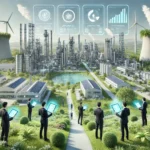Climate change threatens the very foundation of our planet. Rising temperatures, melting glaciers, and increasing sea levels are stark reminders of the urgent need for action. From extreme weather events to the loss of biodiversity, the impacts are being felt worldwide. To counter this, we must leverage every tool at our disposal, including the latest technological advancements. Let’s explore how technology can help us in our fight against climate change.
The Climate Crisis: A Call for Immediate Action
Our planet is warming at an alarming rate. The past few decades have been the warmest in modern history, primarily due to human activities like burning fossil fuels. This has led to significant changes in our climate system, such as:
- Rising Temperatures: Global surface temperatures are increasing, leading to heatwaves and altering weather patterns.
- Melting Glaciers and Ice Caps: This contributes to rising sea levels, threatening coastal communities.
- Ocean Acidification: Increased CO2 levels are making oceans more acidic, harming marine life.
- Extreme Weather Events: More frequent and severe storms, droughts, and floods.
These changes are primarily driven by greenhouse gases like carbon dioxide (CO2), methane (CH4), and nitrous oxide (N2O) trapping heat in the Earth’s atmosphere. To mitigate climate change, we need to reduce these emissions and find ways to remove them from the atmosphere.
Technological Solutions for Climate Mitigation
Renewable Energy Sources
Switching from fossil fuels to renewable energy is crucial. Here are some promising renewable energy sources:
- Solar Power: Harnessing energy from the sun to generate electricity.
- Wind Power: Using wind turbines to produce clean energy.
- Hydroelectric Power: Generating power from water flow in rivers and dams.
These sources produce minimal greenhouse gases and can meet a large portion of our energy needs.
Negative Emissions Technologies (NETs)
NETs aim to remove CO2 from the atmosphere. Key strategies include:
- Afforestation and Reforestation: Planting trees to absorb CO2.
- Soil Carbon Management: Using agricultural practices to increase carbon levels in soils.
- Ocean Fertilization: Adding nutrients to oceans to stimulate algae growth that absorbs CO2.
Carbon Capture and Storage (CCS)
CCS involves capturing CO2 emissions from power plants and industrial processes and storing them underground. This prevents CO2 from entering the atmosphere and helps in reducing overall emissions.
Advanced Agricultural Practices
Innovations in agriculture can significantly reduce emissions:
- Precision Farming: Using technology to optimize crop yields and reduce waste.
- Dietary Supplements for Livestock: Reducing methane emissions from livestock through improved feed.
Energy Efficiency Measures
Improving energy efficiency across various sectors can greatly reduce energy consumption and greenhouse gas emissions:
- Building Retrofits: Upgrading buildings to be more energy-efficient.
- Transportation Upgrades: Investing in electric vehicles and public transit systems.
Management Systems and ICT
Technologies that reduce pollution before it forms can make a big difference:
- Environmental Monitoring: Using sensors to track air and water quality.
- Smart Cities: Utilizing ICT to optimize energy use and reduce pollution.
Space Technology
Satellites play a crucial role in monitoring environmental changes and tracking carbon emissions. This data helps policymakers make informed decisions.
Food Sector Innovations
Innovative approaches are being explored to reduce the environmental impact of food production:
- Lab-Grown Meat: Reducing the need for traditional livestock farming.
- Genetically Engineered Crops: Enhancing crop efficiency and reducing emissions.
The Path Forward
While these technologies offer hope, their widespread adoption requires coordinated efforts from governments, businesses, and individuals. Here are some steps to move forward:
Policies and Regulations
Governments need to enact policies that incentivize the use of clean technologies and support the transition to a low-carbon economy.
Business Investments
Businesses must invest in sustainable practices and innovative solutions to reduce their carbon footprint.
Individual Actions
As individuals, we can contribute by:
- Reducing energy consumption.
- Supporting renewable energy initiatives.
- Advocating for climate action.
Conclusion: Our Collective Responsibility
The battle against climate change is a collective one. Technological innovations provide us with powerful tools to mitigate its impacts. By embracing these solutions and working together, we can create a sustainable future for generations to come. Every action counts, and together, we can make a significant difference.
















